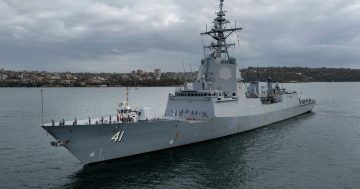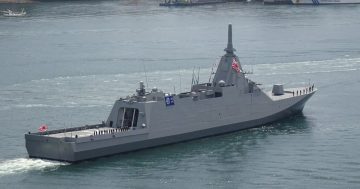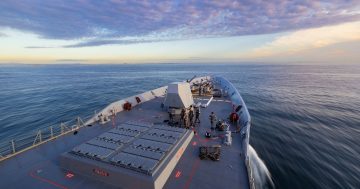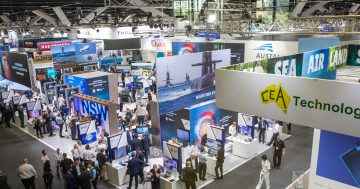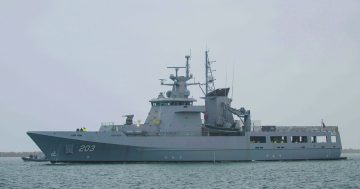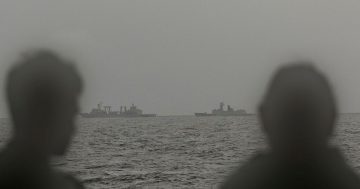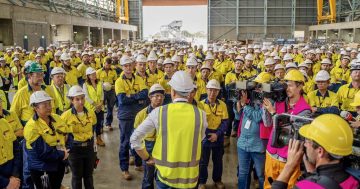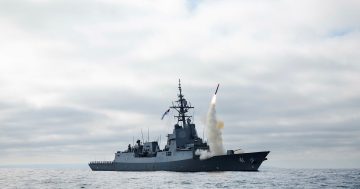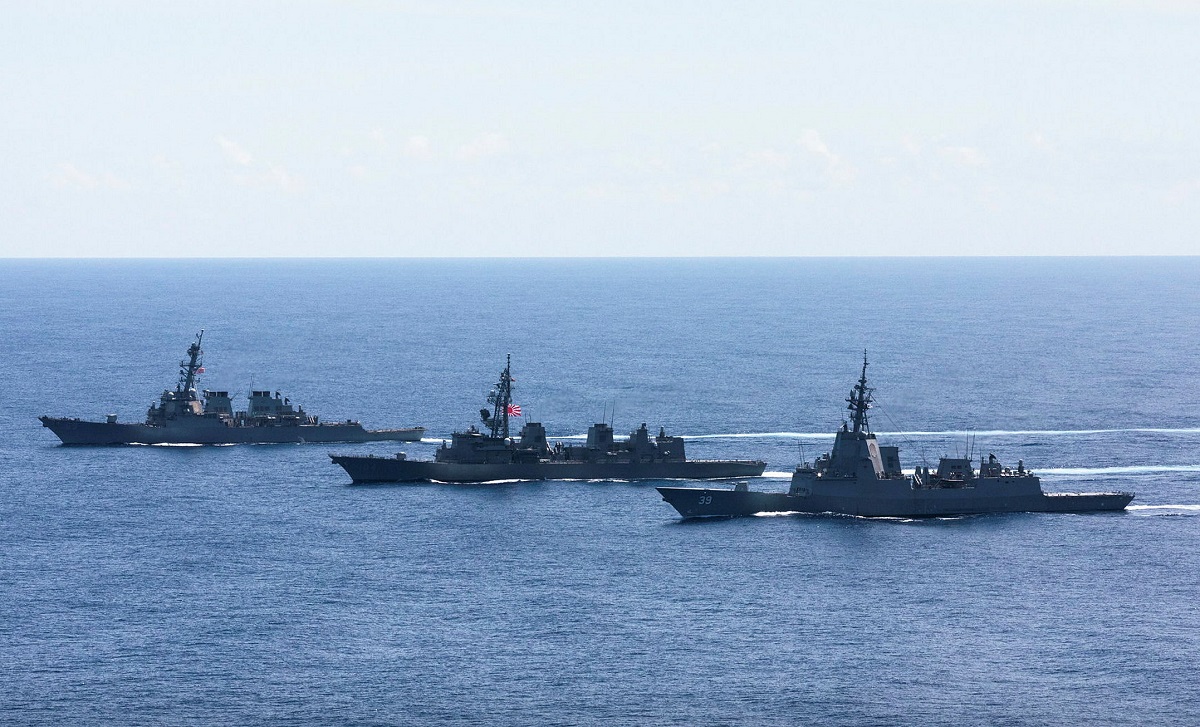
HMAS Hobart (foreground) sails in formation with Japanese and US destroyers during an exercise. Photo: ADF.
One of the key elements to come out of April’s Defence Strategic Review (DSR) was that a further review should be conducted into the Royal Australian Navy’s current surface combatant fleet build programs.
The DSR suggested, with the plan to acquire at least nuclear-powered submarines to replace the Collins class conventional boats, the current plans for the Navy’s surface fleet should be subject to an independent analysis due to be delivered to government by 30 September.
Conducted by retired US Navy Vice Admiral William Hilarides – a former submariner and commander of US Naval Sea Systems Command – the analysis will seek to ensure the current and future surface fleet is appropriately matched to the new submarines when they enter service from 2032, and are suitable in the expected short and medium-term operating environment.
“As a maritime nation dependent on our sea lines of communication, it is essential the size structure and composition of the Navy’s surface combatant fleet is appropriate to our strategic circumstances,” a Defence information webpage states.
“The independent analysis will review Navy’s surface combatant fleet capability to ensure its size, structure and composition complement the capabilities provided by the forthcoming conventionally armed, nuclear-powered submarines.”
The RAN currently has three main classes of surface combatants in its current fleet – three Hobart class destroyers which entered service from 2016, eight ANZAC class frigates due to be replaced from 2028, and a mix of about 12 Armidale and Cape class patrol boats operated by RAN and Border Force personnel.
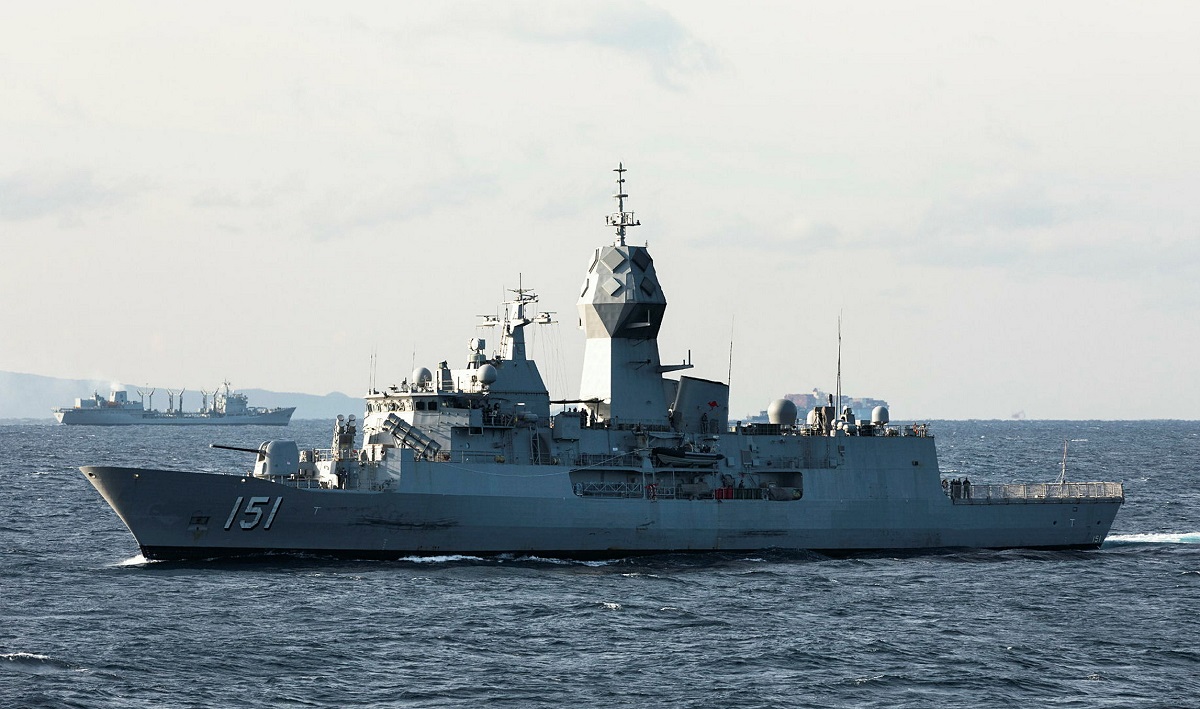
The ANZAC class has been upgraded with new radars and combat systems, but is due to be replaced from 2030. Photo: ADF.
Also to be assessed under the review will be the suitability of the two Canberra class amphibious landing helicopter docks (LHD), two Supply class auxiliary oiler replenishment (AOR) vessels, and other support vessels.
The Hobart class vessels will soon undergo a substantial upgrade to their Aegis combat system, SPY-1D radar and other systems, and receive new weapons such as the Tomahawk cruise missile.
The Hobarts are well equipped and well armed. But despite their designation, they are essentially large frigates.
Frigates traditionally sit between smaller corvettes and larger destroyers, with a specialist anti-submarine warfare (ASW) and secondary air warfare role. But while the Hobarts have a comprehensive ASW suite, they are essentially air warfare specialists.
The Hobarts also lack magazine depth compared to other destroyers in the region, particularly the US Navy’s Arleigh Burke, and the Chinese Type 52D and Type 55 classes. The 7000 tonne Hobart’s 48 vertical launch system (VLS) cells are over-matched by the 9500-plus tonne Arleigh Burke’s 90 or 96 VLS cells and the 7500 tonne Type 52D’s 88 cells, while the 12,000-plus tonne Type 55 packs a whopping 126 VLS cells.
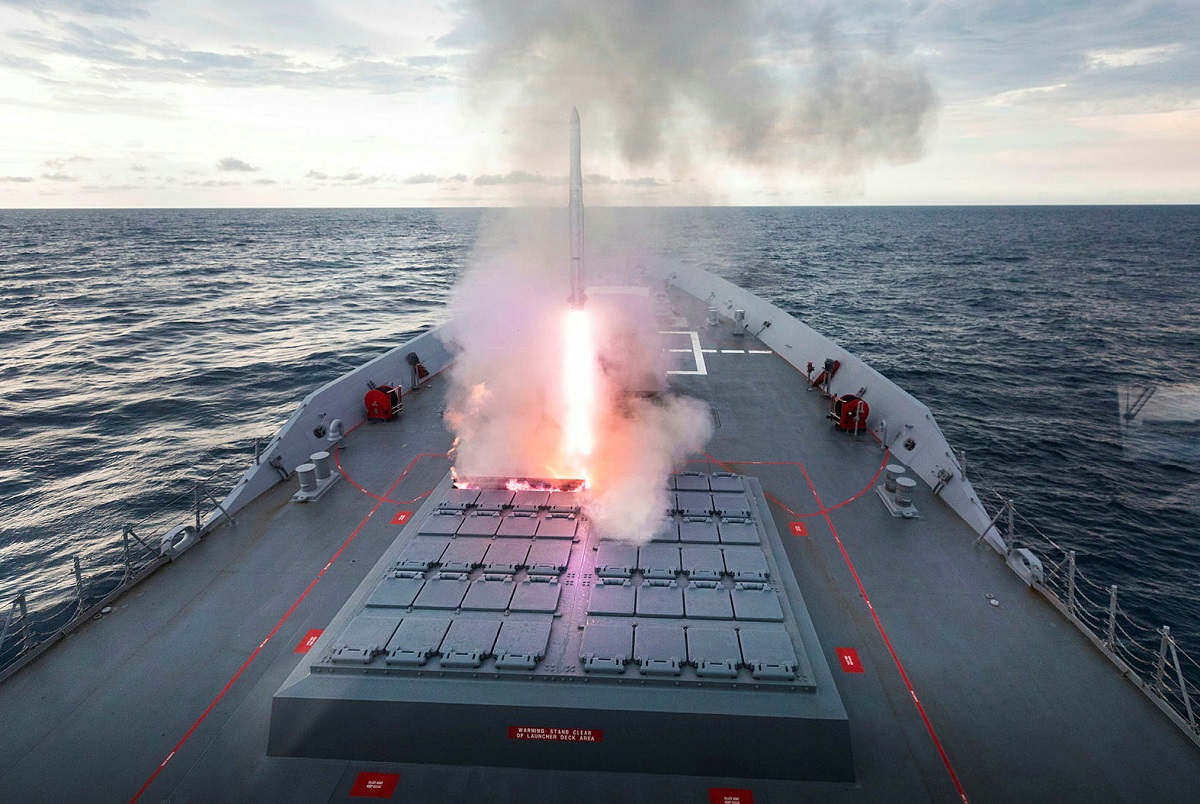
The Hobart class destroyers have 48 VLS cells, far fewer than regional equivalents. Photo: ADF.
But not all VLS cells are created equal, and all of the Mk41 VLS used by Australia and the US are able to each carry a quad-pack of short-range anti-aircraft missiles such as the Raytheon ESSM instead of just a single larger missile each.
The ANZAC class entered service between 1996 and 2006, and will soon complete a fleet-wide upgrade of primary and anti-air radars and combat systems. The smaller ANZACs displace about 4000 tonnes, and are due to start being replaced in service from 2030 by nine Hunter class frigates built by BAE Systems in Adelaide.
During its delayed design phase, the planned Hunter class frigate has seen a growth in weight to more than 9500 tonnes, a point at which it could well and truly be classed as a destroyer.
But questions have been raised about how much growth margin remain in the face of the design’s weight gains. Metal is yet to be cut on the first Hunter and the program’s future remains uncertain until the findings of the review are published.
When asked about the future of the Hunter class program last weekend, Defence Minister Richard Marles told SKY News he wouldn’t react to speculation. He said the government would “take our time to work through that and to make the announcements in relation to that in due course”.
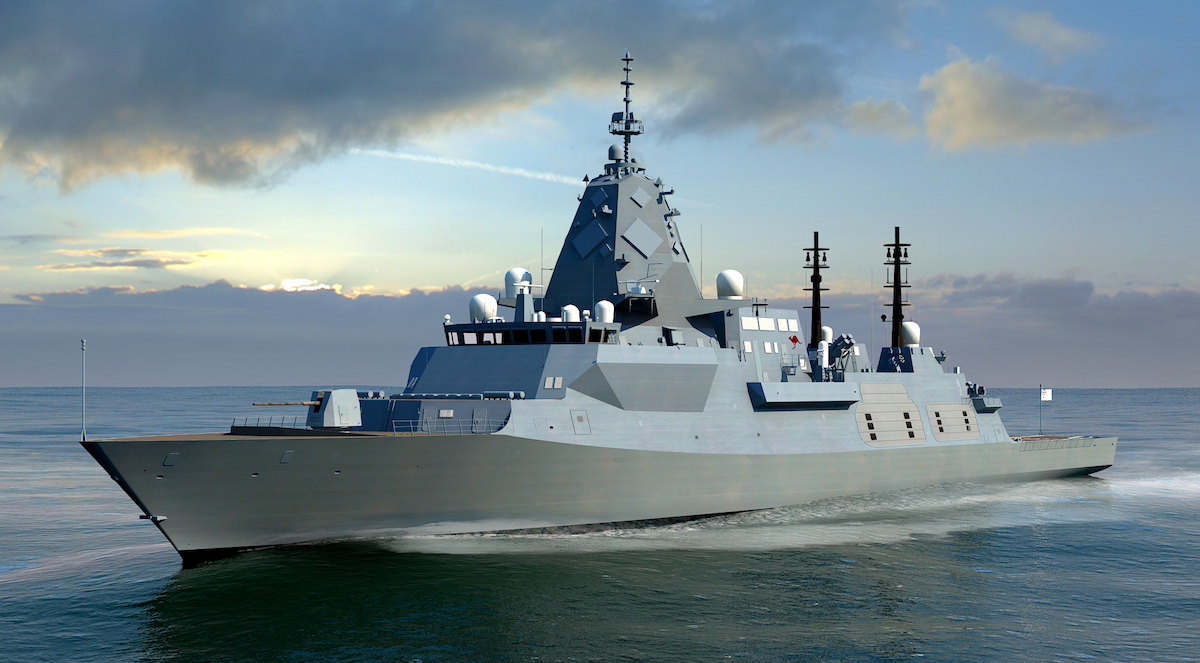
Concept art of the planned Hunter class frigate. Image: BAE Systems.
The Armidale class patrol boats are currently being phased out in favour of similar but improved Cape and Evolved Cape class patrol boats. These are an interim solution and will be augmented and later replaced by 12 Arafura class offshore patrol vessels (OPV) currently in construction in Adelaide and at Henderson near Fremantle.
But questions have also been asked about the future of the Arafura program. Built by Luerssen Australia, at 1600 tonnes they are about four times the size of the patrol boats they will replace. But while they have a flight deck, the Arafuras don’t have a hangar so cannot embark a helicopter. And they also lack any large-calibre weapons system after the planned main deck gun was cancelled early in the program.
So the Arafura program may also be up for review, especially with shipbuilders – including Luerssen itself with its C90 derivative of the Arafura OPV – pitching a larger corvette-sized alternative to the reviewing body.
Possible solutions put forward by Admiral Hilarides could include adding more destroyers at the expense of some frigates, and the fitting of anti-ship missiles and a new main deck gun to the Arafuras. Another option would be to introduce more smaller and cheaper corvette-sized vessels instead of some of the larger Hunter class.
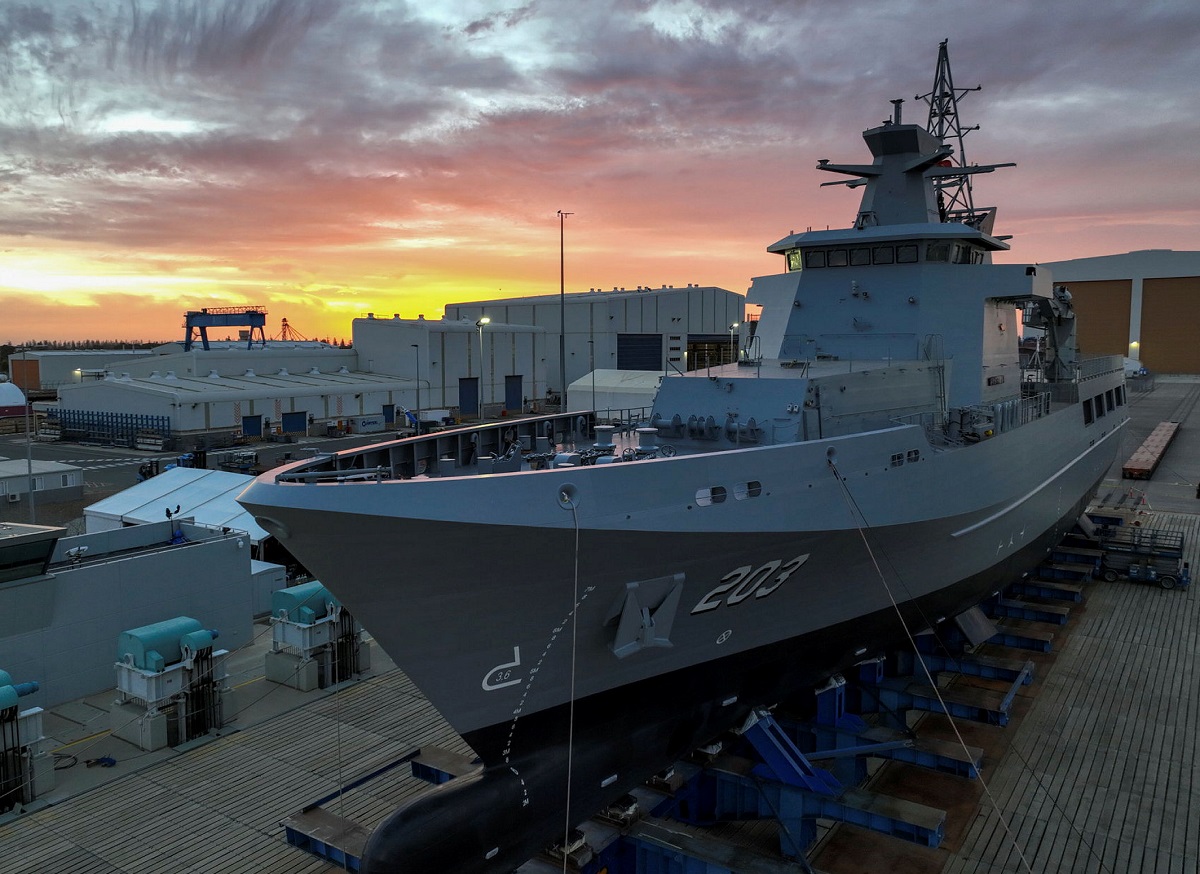
The first Arafura class OPV shortly before being launched in 2022. Photo: ADF.
Original Article published by Andrew McLaughlin on Riotact.


